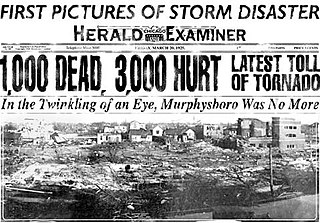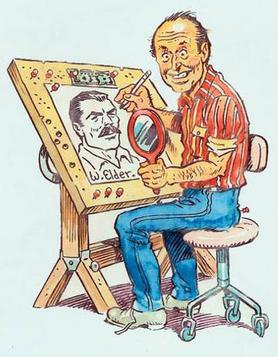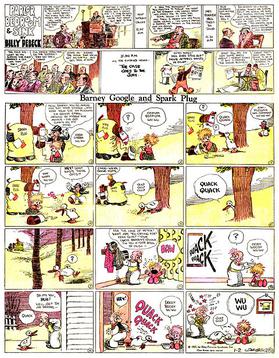Related Research Articles
A comic strip is a sequence of cartoons, arranged in interrelated panels to display brief humor or form a narrative, often serialized, with text in balloons and captions. Traditionally, throughout the 20th and into the 21st century, these have been published in newspapers and magazines, with daily horizontal strips printed in black-and-white in newspapers, while Sunday papers offered longer sequences in special color comics sections. With the advent of the internet, online comic strips began to appear as webcomics.

Garfield is an American comic strip created by Jim Davis. Originally published locally as Jon in 1976, then in nationwide syndication from 1978 as Garfield, it chronicles the life of the title character Garfield the cat, his human owner Jon Arbuckle, and Odie the dog. As of 2013, it was syndicated in roughly 2,580 newspapers and journals and held the Guinness World Record for being the world's most widely syndicated comic strip.

The Chicago American was an afternoon newspaper published in Chicago under various names from 1900 until its dissolution in 1975.

Gasoline Alley is a comic strip created by Frank King and distributed by Tribune Content Agency. It centers on the lives of patriarch Walt Wallet, his family, and residents in the town of Gasoline Alley, with storylines reflecting traditional American values.

Moon Mullins is an American comic strip which had a run as both a daily and Sunday feature from June 19, 1923, to June 2, 1991. Syndicated by the Chicago Tribune/New York News Syndicate, the strip depicts the lives of diverse lowbrow characters who reside at the Schmaltz boarding house. The central character, Moon, is a would-be prizefighter—perpetually strapped for cash but with a roguish appetite for vice and high living. Moon took a room in the boarding house at 1323 Wump Street in 1924 and never left, staying on for 67 years. The strip was created by cartoonist Frank Willard.
Comparative psychology refers to the scientific study of the behavior and mental processes of non-human animals, especially as these relate to the phylogenetic history, adaptive significance, and development of behavior. The phrase comparative psychology may be employed in a narrow and a broad meaning. In its narrow meaning, it refers to the study of the similarities and differences in the psychology and behavior of different species. In a broader meaning, comparative psychology includes comparisons between different biological and socio-cultural groups, such as species, sexes, developmental stages, ages, and ethnicities. Research in this area addresses many different issues, uses many different methods and explores the behavior of many different species from insects to primates.

Alley Oop is a syndicated comic strip created December 5, 1932, by American cartoonist V. T. Hamlin, who wrote and drew the strip through four decades for Newspaper Enterprise Association. Hamlin introduced a cast of colorful characters and his storylines entertained with a combination of adventure, fantasy, and humor. Alley Oop, the strip's title character, is a sturdy citizen in the prehistoric kingdom of Moo. He rides his pet dinosaur Dinny, carries a stone axe, and wears only a fur loincloth.
Annoyance is an unpleasant mental state that is characterized by irritation and distraction from one's conscious thinking. It can lead to emotions such as frustration and anger. The property of being easily annoyed is called irritability.

William Elder was an American illustrator and comic book artist who worked in numerous areas of commercial art but is best known for a frantically funny cartoon style that helped launch Harvey Kurtzman's Mad comic book in 1952.

Joseph Medill Patterson was an American journalist, publisher and founder of the Daily News in New York. At the time of his death the Daily News maintained a Sunday circulation of 4.5 million copies, the largest circulation of any paper in the United States.

Frank Oscar King was an American cartoonist best known for his comic strip Gasoline Alley. In addition to innovations with color and page design, King introduced real-time continuity in comic strips by showing his characters aging over generations.

The Sunday comics or Sunday strip is the comic strip section carried in most western newspapers. Compared to weekday comics, Sunday comics tend to be full pages and are in color. Many newspaper readers called this section the Sunday funnies, the funny papers or simply the funnies.
Richard Arnold Moores was an American cartoonist whose best known work was the comic strip Gasoline Alley, which he worked on for nearly three decades.

James Scancarelli, known professionally as Jim Scancarelli, is an American cartoonist and musician. Since 1986, he has been writing and drawing the syndicated comic strip Gasoline Alley for Tribune Media Services. In that role, his predecessors were Frank King, Bill Perry and Dick Moores. He had served as an assistant to the latter for several years before taking over. Scancarelli is also a prizewinning bluegrass fiddler.
Mick Napier is an American director and improvisational theater teacher. He is the founder and artistic director of the Annoyance Theatre and a director at The Second City. He has directed Stephen Colbert, Tina Fey, Rachel Dratch, Horatio Sanz, Nia Vardalos, Andy Richter, Jeff Garlin, and David Sedaris.

Tribune Content Agency (TCA) is a syndication company owned by Tribune Publishing. TCA had previously been known as the Chicago Tribune Syndicate, the Chicago Tribune New York News Syndicate (CTNYNS), Tribune Company Syndicate, and Tribune Media Services. TCA is headquartered in Chicago, and had offices in various American cities, the United Kingdom, the Netherlands, and Hong Kong.
A comic strip syndicate functions as an agent for cartoonists and comic strip creators, placing the cartoons and strips in as many newspapers as possible on behalf of the artist. A syndicate can annually receive thousands of submissions, from which only two or three might be selected for representation. In some cases, the work will be owned by the syndicate as opposed to the creator. The Guinness World Record for the world's most syndicated strip belongs to Jim Davis' Garfield, which at that point (2002) appeared in 2,570 newspapers, with 263 million readers worldwide.
William Miles Perry was an American cartoonist, known as an assistant on, and later a primary artist for, the Gasoline Alley comic strip.
Sunday Press Books is an American publisher of comic strip reprint collections founded in 2005 by Peter Maresca. The company is known as a respected reprinter of comic strips and has to date won three Eisner Awards and two Harvey Awards. Since 2022 the company is partnered with Fantagraphics in distribution and marketing.
Walt and Skeezix is a hardcover book collection of the daily comic strips of Gasoline Alley, an American comic strip written and drawn by Frank King, originally syndicated in newspapers by Tribune Content Agency between 1918 and 1969. The collection is published by the Canadian publisher Drawn & Quarterly; the first volume of the series was released in 2005.
References
- ↑ Barnhart, Robert K., ed. (1988). Chambers Dictionary of Etymology. Edinburgh: Chambers Harrap Publishers Ltd. p. 770. ISBN 0-550-14230-4.
- ↑ "King Comics: Daily and Sunday". Editor & Publisher: 1. March 8, 1919.
- ↑ "King, Creator of 'Gasoline Alley,' Dies". Chicago Tribune. June 25, 1969. Retrieved 25 May 2018.
- ↑ "Chicago Tribune".
- ↑ Kowalski, Robin M. (2003). Complaining, Teasing, and Other Annoying Behaviors. Yale University Press.
- ↑ James, Leon. "Congressional Testimony on Road Rage".
- ↑ Green, Thad B., Jay T Knippen (1999). Breaking the Barrier to Upward Communication. Quorum/Greenwood. pp. 34–37.
{{cite book}}: CS1 maint: multiple names: authors list (link)